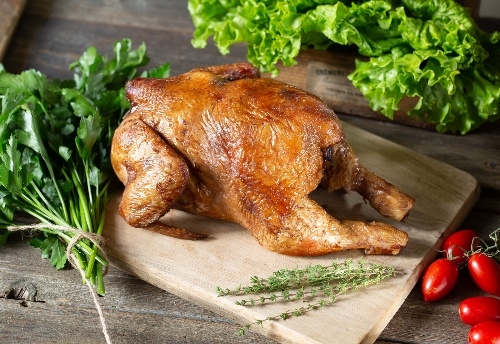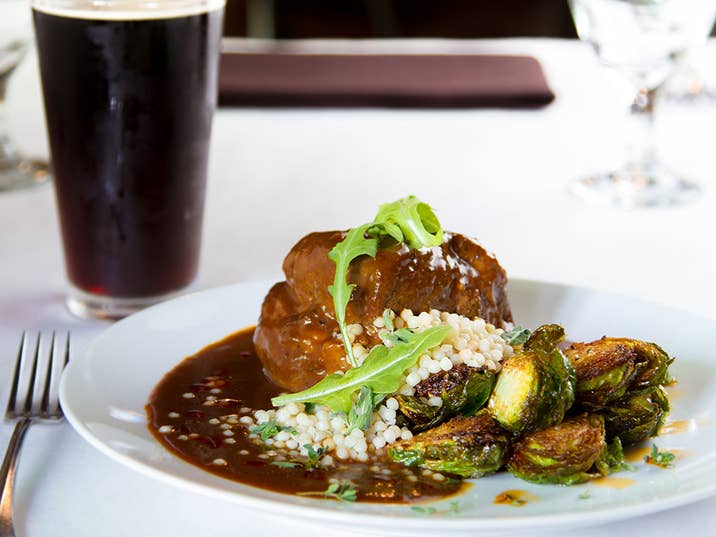Tips for Buying Meat & Saving Money
Tips for buying meat
Top tips for what to look for when buying meat, finding the right cuts and saving money on your groceries.
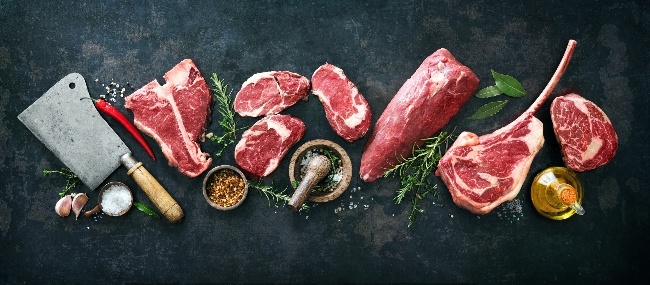
What to look for when buying meat
When you’re shopping on a budget, it’s a good idea to try to save money on meat. It’s crucial that every bit of meat you buy can be used to keep your family fed. One great way to get your money’s worth is to ensure you’re buying the best meat on offer. There are a few things to keep an eye out for regardless of the meat you’re buying:
- Avoid meat in damaged packaging.
- Always check the best before date.
- Buy only what you need.
- Aim for lean cuts when possible.
What to look for when buying mince
You can usually find mince made from beef, lamb, pork or chicken. Beef mince in particular is a popular choice for many weeknight meals.

- Beef mince: This is the most affordable option, but is often higher in fat. It’s a great choice for homemade burgers, but for chilli or bolognese you may want to drain excess fat after cooking.
- Prime beef mince: With a little less fat, prime mince is right in the middle. It’s a better pick for bolognese, while still being affordable.
- Premium beef mince: Finally, with the least amount of fat, premium mince is the most economical option. It costs more upfront, but you’re paying more for meat - not fat that will get drained off.
In general, red meat mince will look bright red in colour. However, if the mince is starting to look a bit brown, there’s no need to worry - this is simply a natural reaction to oxygen and not an indication of quality. Fresh chicken mince should look light and fairly translucent. While pork should be light pink with flecks of white fat in it. Avoid mince of any kind that is grey or sour smelling.
What to look for when buying beef
Beef cuts range from steaks and diced casserole meat through to whole joints for roasting or slow cooking.
Quality cuts of beef will usually be a bright cherry red colour, however shrink-wrapped meat may appear darker or more purple. White parts on a cut of beef are typically fat. Fat sits in caps around the edges of steak or on the surface of roasting joints. Fat caps like these can be eaten, but many people prefer to cut them off. Fat can also be marbled through the steak, and appear as smaller veins of white through the red meat. Marbling like this is often an indication of quality, and makes the meat extra tender and flavourful.
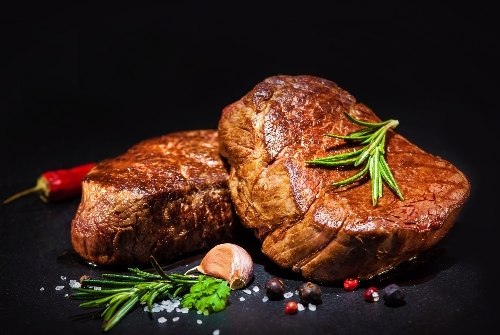
Different cuts of beef
Below are a few common cuts of beef and what you might use them for:
Beef frying steak
- Rump steak: Rump is the most affordable “frying steak”. It’s a bit leaner than other frying steaks and firmer in texture. It’s often sold in large steaks, which are best when cooked and then thinly sliced.
- Sirloin steak: Sirloin steaks are often somewhat rectangular steaks, with a single cap of fat along one side and some marbling. Remove the fat cap after cooking to allow it to impart lots of flavour in the pan.
- Scotch steak: With more marbling and a strip of fat running through the steak, scotch is a popular pan steak for its tender texture and rich flavour. There’s no need for any oil in the pan, because the fat will render out and stop the steak from sticking.
- Eye fillet steak: This is often considered the most premium cut of beef, taken from between the ribs of the cow. Because the muscle does very little work, the steak is especially tender.
- T-bone steak: A t-bone steak is actually a sirloin and an eye fillet connected by a t-shaped bone. With great quality steak on both sides, this is a large and impressive cut perfect for entertaining. Toss it on the BBQ then slice to share.
Beef cuts best for slow cooking
- Chuck steak: Chuck steak is made up of a lot of different muscles and connective tissue. It needs a low and slow cooking method in order to break down and become tender. Use for casseroles and stews.
- Blade steak: Like chuck, blade requires a slow cooking to break down. However, it can also be very thinly sliced for stir frying.
- Cross cut blade steak: Cross cut steaks have a line of gristle down the centre which, when slow cooked turns to gelatine. This extra connective tissue makes for a slightly more luscious result.
- Gravy beef: Cut from various tougher parts of the cow, gravy beef is full of connective tissue meaning it needs long slow cooking but has loads of flavour.
Whole beef joints
- Brisket: This is a budget-friendly cut taken from the well-worked muscle of the cow’s chest. The brisket is full of connective tissue and when slow-cooked is perfect for pulling and mixing with your favourite barbecue sauce. Serve pulled brisket in sliders or on its own with a coleslaw on the side.
- Bolar roast: Bolar roast is an economic way to feed a crowd. Roast this joint low and slow for tender, delicious slices of roast beef. Or, cut the whole piece down into smaller chunks and use it for a casserole or stew.
- Topside: Topside is very similar to bolar, but is cut from the thigh of the cow rather than the shoulder. It can be a little tougher than bolar, so definitely prefers a long, slow cook.
- Corned silverside: Silverside, or corned beef, is actually a cured meat. It’s a roast cut, similar to topside, that has been cured in a salty brine. Although cured, silverside should still be cooked in a pot of simmering water for about 25-30 minutes per 500 grams.
What to look for when buying lamb
Like beef, lamb is a popular and versatile red meat. New Zealand is well-known for producing some of the best quality lamb in the world, so it’s a great one to put on the plate.

As a red meat, lamb should appear red in colour, but is naturally a bit less vibrant than beef. Often you’ll find fresh lamb is a muted red or reddish brown colour. As usual, white edges are generally fat and can be removed or eaten.
Some larger cuts like lamb legs, shanks or racks may have silverskin and exterior fat on them. Silverskin is a thin layer of connective tissue that has a silver-white sheen to it. It can be very tough when cooked, so most people prefer to remove it. Meanwhile exterior fat can be removed, or left on to render down during roasted and baste the rest of the cut, keeping it moist and flavourful.
Different cuts of lamb
Below are a few common cuts of lamb and what you might use them for:
Lamb chops and steaks
- Leg steaks: Leg steaks are cut from the thigh or mid-leg of the lamb and are suitable for both pan frying and slow cooking. Thigh steaks usually have more visible fat and are more tender, perfect for frying. Meanwhile, middle leg steaks will be a more consistent colour with less sign of fat and better suited to slow cooking.
- Loin chops: These tender chops are best cooked hot and fast. Throw them on the barbecue or in a hot frying pan to develop a crispy golden exterior and moist pink interior.
- Shoulder chops:Lamb shoulder chops love a marinade. Let these thin cuts marinate for about an hour then pan fry quickly. Alternatively, slow cook them to let the connective tissue break down and get melt-in-your-mouth meat.
- Loin fillets: Similar to beef tenderloin, the fillet is from the “eye” of the lamb — a tender, barely worked muscle. It’s one of the more premium cuts but when pan fried or grilled can be a real show stopper.
- Rumps: These scrumptious cuts are taken from the top of the leg and are super versatile. Roast, pan-fry or barbecue rumps for juicy pink meat in the middle and a crispy caramelised exterior.
Larger lamb cuts
- Leg roast: Short-cut lamb legs are a medium tenderness, best suited for slow roasting. Bringing a whole roast leg to the table is a surefire way to impress your guests, and there’s ample meat on that bone to feed everyone.
- Butterflied leg: When butterflied, a lamb leg is trimmed, opened and deboned. Essentially, it’s all the meat of a leg roast without the bone or quite as much fat. The varied thickness of the butterflied leg means you can get a great variety of crispy bits and juicy pink meat. This is a must for the barbecue!
- Shanks: The lower portion of the leg, shanks are a full-flavour cut that can stand up to curries and heady red wine sauces. These need to be slow-cooked and when done right will fall off the bone.
- Rack of lamb: A rack of lamb is usually a set of six to eight ribs with some of the most tender meat a lamb has to offer — the “eye”. Roast quickly in the oven and serve medium rare.
What to look for when buying pork
Pork can be polarising, as it’s often overcooked. However, when cooked right, pork is a juicy flavourful meat that takes on most flavours very well, and pairs marvelously with sweet sauces like cranberry, chutney or even a marmalade. Cuts of pork can range from a gentle pink to a deeper red depending on where on the pig the cut is from. Don’t be put off by a slightly translucent pale pink colour, as this is normal for pork. That said, avoid pork that seems to be grey or green.
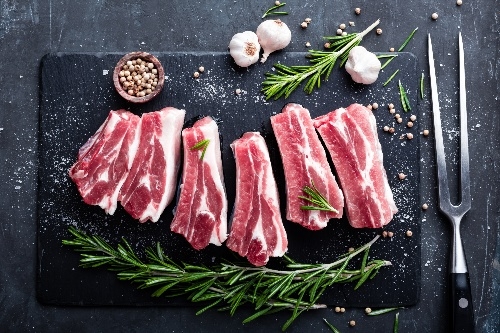
Different cuts of pork
Below are a few common cuts of pork and what you might use them for:
Pork chops and steaks
- Loin chops: This bone-in chop is perfect for pan-frying. It’s similar to a T-bone beef steak, made up mostly of sirloin but with a bone to help with cooking and flavour.
- Shoulder chops: Shoulder chops have more dark meat and lots of connective tissue, gristle and sometimes bone. These are a fantastic cheap cut for a slow-cooked tender pork dish.
- Sirloin: Like sirloin from a cow, pork sirloin is a wonderful frying steak cut. Pork sirloin is especially lean but still nice and juicy when cooked until pink in the middle.
- Scotch: Pork scotch fillet steaks have more fat in them, meaning they’re easier to keep juicy. They benefit from a very hot pan-fry to get that fat rendered and caramelised.
- Eye fillet: The eye fillet or tenderloin is the most premium part of the pork. It’s often very lean and must be cooked to a medium-rare for a beautiful pink centre and juicy, flavoursome meat.
Pork roasting cuts
- Shoulder roast: Pork shoulder is from the front end of the pig and contains a lot of connective tissue. It’s best suited for roasting or slow cooking. Pop it in the crockpot with a favourite sauce for 8 to 10 hours for meltingly delicious pulled pork.
- Leg roast: Leg is a similar cut to shoulder but a bit more lean. The fat cat under the skin is a must-have for roasting a tender pork, as it will melt down during cooking to baste the meat. Meanwhile, the skin should be scored to create crunchy, mouth-watering crackling.
- Spare ribs: These ribs come from the underside of the pig, by the belly. They’re full of meaty flavour and are best cooked for a long time to get nice and tender. Great ribs will have meat falling off the bone in a delicious smoky barbecue sauce.
- Pork belly: The belly of the pork is used to make streaky bacon, but it’s also a very succulent roast. Three or four hours in the oven gets you perfect crackling, rendered fat and rich buttery pork meat.
- Hocks: Pork or ham hocks are from the leg of the pig. They aren’t particularly meaty, but can impart a lot of flavour into a soap or stew.
What to look for when buying chicken
Chicken is a go-to for many families because it’s economical and extremely versatile. Bone-in cuts are often cheaper and full of flavour, but still don’t require the same extended cooking time you might expect of bone-in pork. Meanwhile lean chicken breast is a wonderful healthy option and dark chicken thigh brings lots of flavour to curries. When buying chicken, look for a consistent smooth colour in light meat. Dark meat such as thighs may have some variation, but this is normal. Skin-on pieces may show parts of a feather still on the skin sometimes. Simply pull the pin feather out before eating. See our guide to how to cook chicken.
Different cuts of chicken
Below are a few common cuts of chicken and what you might use them for:
Boneless chicken
- Chicken breast: Breast meat is lean and delicious. Super versatile, breast can be baked whole, sliced to half the thickness and pan-seared or diced for a stir-fry. Breast can dry out more easily than darker meat, so be careful not to overcook it.
- Chicken thigh: The thigh contains a lot of dark meat, which stays juicy and flavoursome even after long or hot cooking. Thigh is wonderful for curries and casseroles.
- Chicken tenderloins: Sometimes attached to breasts when you buy them, tenderloins are smaller strips of chicken which are especially tender and succulent. They’re popularly battered and fried to become chicken tenders.
Bone-in chicken
- Chicken drumsticks: These are the lower leg of the chicken. They have a central bone run through them, some cartilage and a fair bit of skin. The skin can be nice and crispy when roasted or barbecued. The bottom of the drumstick has very little meat but makes a fantastic handle for finger-food at a BBQ.
- Bone-in thigh: Thigh meat is already perfect for a curry, but for even longer cooks you may like to use bone-in thigh. The bone keeps the meat extra succulent and imparts lots of flavour into your sauce or gravy.
- Thigh cutlets: These are similar to bone-in thighs, however are usually skinless and trimmed of extra bone pieces. As a result, they only have a single bone running through them.
- Chicken nibbles: Nibbles are made up of the parts of a chicken wing, namely the drumette and wingette. These are perfect for baking then tossing in your favourite hot sauce to feed a crowd during the big game.
- Chicken legs: Legs are larger cuts which include the whole thigh and drumstick. These can be used in exactly the same way as either cut, but have more meat and are generally bigger portions.
- Chicken wings: Wings are the complete in-tact cut that consists of both types of chicken nibbles, as well as the wing tip. These can be used in the same way as chicken nibbles, but are larger and the wing tip can be a yummy bit of crispy cartilage for chewing on.
- Whole chicken: A whole chicken can be broken up into pieces if you like, but is best used for roasting whole with your favourite flavours.
- Butterflied chicken: A butterflied chicken has had its spine removed and has been flattened, creating a more even thickness throughout the chicken. This allows the heat to get to the whole chicken at the same time, meaning it cooks faster and more evenly.
For more on chicken, head on over to our extensive range of chicken recipes.
When buying beef mince, you’ll usually have three options:
